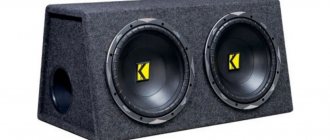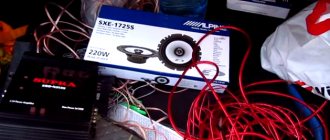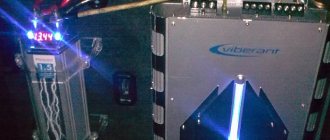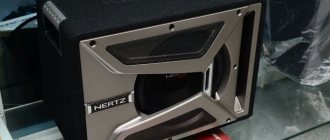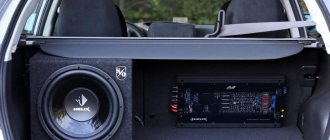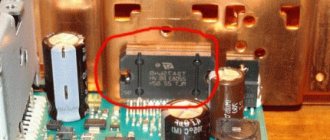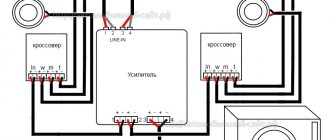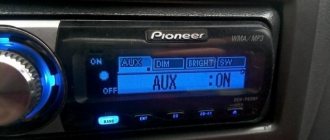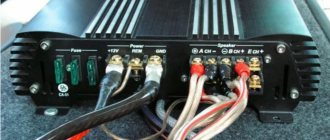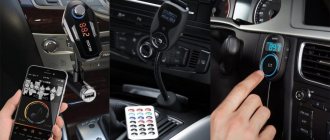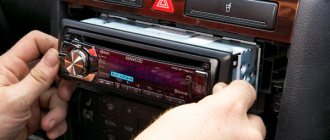When car owners are not satisfied with the sound of the car radio, additional equipment is installed in the car. These may be the following nodes:
- Amplifier
- Crossovers
- Acustic systems
- Subwoofer
This set of technical means allows you not only to increase the sound volume, but also to significantly improve the quality of music playback. The question of how to connect a car amplifier is not as simple as it seems. The simplest version uses a ULF and two front speakers, providing high-quality stereophonic sound. A more complex option involves connecting two front and two rear speaker systems. The maximum configuration is implemented according to the 4+1 scheme and includes four speakers and a subwoofer. In addition, the automotive system provides crossovers, which are adjustable high- and low-pass filters. They also perform the function of frequency division of the signal into separate speakers for each channel.
Often, various problems arise when connecting on-board electronics. Typically, difficulties arise when supplying power to the output device and connecting speaker systems to it. You can connect a car amplifier yourself, but to do this you need to have basic skills in electrical engineering and working with tools. Most often, a crackling sound from the operation of the ignition system is heard in the speakers, and the sound in the speakers is distorted with limited high frequencies. There may be several reasons that cause such shortcomings. Often the sound quality is affected by the poor quality of the amplifier and speakers when technical equipment is purchased secondhand, but it happens that branded equipment sounds very bad. Correctly connecting the amplifier to the car will get rid of all problems.
Connecting a subwoofer to a 4-channel amplifier
The quality of listening to music programs in a car depends on the parameters of two main components. These are speaker systems and a low-frequency unit used to connect speakers. Additional factors that ensure good sound are connecting wires and their proper installation in the cabin. Car sound systems have different numbers of channels. A four-channel block is considered a universal design. It allows you to connect a subwoofer, front speakers and rear speakers to a 4-channel amplifier.
How to connect a sub to a 4 channel amplifier
Connecting a subwoofer to a 4-channel amplifier will provide excellent sound quality in the car. Separate low-frequency amplification paths allow you to connect front and rear speakers and a subwoofer to a four-channel device.
Connecting a subwoofer to a four-channel amplifier can be done in two ways. In the first case, the connection of the speaker systems looks like this:
- Channel one – front speakers
- Second channel – rear speakers
- The third and fourth are a bridge subwoofer
The second option implies that the four-channel unit will be used only for the subwoofer. In this case, two low-frequency speaker systems are connected. One in the first and third channels, and the second in the third and fourth. Connecting a subwoofer with a bridge to a 4-channel amplifier is considered the most convenient option. This configuration means that the low-frequency sound system is connected between the plus of one channel and the minus of the second as shown in the figure.
Bridging a 4-channel amplifier to a subwoofer should be done very carefully. The instructions for the amplifier indicate the minimum permissible impedance of the loudspeakers, which can be used on one channel or on two channels in a bridge connection. Connecting a subwoofer to a 4-channel amplifier may have limitations, since some models allow connecting a speaker with a resistance of at least 4 ohms. When connecting a four-channel amplifier to a subwoofer, it is important not to reverse the polarity and make the connection as shown in the diagram.
Before installing the connecting cable onto the screw terminal, it must be thoroughly cleaned to remove the oxide film from the surface of the copper. You need to unscrew the screw, make a copper loop at the end of the cable and tighten it under the washer. If you only clamp the end of the cable, vibration may weaken the thread and the wire will come out from under the washer.
Connecting speakers to an amplifier in a car
Connecting a car amplifier to speakers is not difficult if there are only two channels. On the back wall of the device there are screw terminals for connecting speakers. They indicate the polarity of the connection. Signs “+” and “–” are also available on speaker systems. It is enough to use the correct connecting cables and not make the wrong polarity when connecting. The REM (Remout Control) wire or remote control is designed to turn on the amplifier from the car radio. When it is turned on, a control voltage of +12 V is supplied to the wire and the device turns on. The connection diagram of a car amplifier to the radio implies automatic control of the power supply of the power unit, but some car enthusiasts install a toggle switch and supply the switching voltage through it.
How to connect a four-channel amplifier to a subwoofer
Connecting a 4-channel amplifier to a subwoofer by bridge is carried out with a copper stranded wire of the appropriate cross-section. This is an acoustic cable designed specifically for connecting speaker systems, especially high power ones. Ready-made kits are available for sale, but it is not recommended to buy them. They are inexpensive, but have low quality insulation. Some manufacturers offer connecting cables with copper-coated steel cores. You cannot connect a 4-channel amplifier to a subwoofer with such wires.
A low-frequency speaker system is usually placed in the luggage compartment of a car, and a low-frequency system can be installed in the passenger compartment or in the trunk. Therefore, the cable consumption will be small. To connect a subwoofer to a 4-channel amplifier, you need to select the cross-section of the connecting wires. For most systems, a cross-section of 4 mm2 will be sufficient, and for very powerful speakers 6-8 mm2. There is a well-known rule - the thinner the speaker cable, the worse the playback quality. This is especially true for low frequencies, so there is no need to skimp on cable cross-section.
Connection diagram for an amplifier in a car
Connecting car speakers to an amplifier is carried out with copper stranded wires, which can be laid in the lower part of the cabin or on top under the decorative upholstery. The top connection is considered more reliable. The subwoofer is usually placed in the trunk of a car, so it should be securely mounted. The amplifier output is implemented in the form of screw terminals or via RCA connectors (Tulip). In the second case, it is better to purchase a ready-made set of connecting cables.
Connecting a car amplifier to a radio is not difficult , since its outputs and inputs of the amplifier are equipped with RCA connectors. The outputs of the left and right channels of the car radio are connected to similar input connectors of the terminal device. All screw connections should be tightened to maximum torque to ensure reliable contact when driving on any road. If you do everything correctly, according to the descriptions and drawings, then there will be no problems connecting a sound amplifier in the car.
Connect 4 channel amplifier to 1 subwoofer
Some car enthusiasts install two loudspeakers in a closed box or bass reflex to get powerful and rich bass. Connecting a subwoofer to a 4-channel amplifier is done using a bridge circuit, but each two channels will work as a bridge to their own speaker. It will no longer be possible to connect other speaker systems, but the bass will be exceptionally strong and dense. To organize sound in the car interior, you will need a separate low-frequency unit. The connection diagram for one subwoofer for 4 channels is made with a thick acoustic cable in compliance with all reliability requirements. It is best to lay the cable in a corrugated plastic sleeve. The plastic material used to make the hoses does not support combustion so that in the event of a short circuit, fire can be avoided. It is important to secure cable lines with ties to avoid breakage in case of strong vibration.
There are several types of car audio amplifiers
- A two-channel amplifier for a car involves connecting two front or two rear speakers. Also used to connect a subwoofer. It is very rare to connect 4 speakers.
- A four-channel car audio amplifier allows you to connect two front and two rear speakers. Another option is possible: in two channels there are two speakers, and the other two channels are connected by a bridge to the subwoofer. In the case of a subwoofer, it is difficult to achieve good sound pressure. It is preferable to use two two-channel amplifiers.
- If the device is five-channel, four channels are for speakers, and the fifth is for the subwoofer. As in the previous option, when connecting a subwoofer, most of the amplifier's power will be used to reproduce low frequencies. It may not be enough for mid and high frequencies. A five-channel amplifier is a good option for listeners who are undemanding in terms of volume levels.
- Monoblock - an amplifier with one channel for a subwoofer.
On car amplifiers, connectors are grouped into groups depending on their purpose:
How to connect a subwoofer to a 4-channel amplifier yourself
How to connect a subwoofer to a 4 channel amplifier
How to connect a subwoofer to a 4-channel amplifier without losing power? What needs to be done so that the connection diagram of a subwoofer to a 4-channel amplifier is fully and correctly implemented? All these questions require answers, which we will try to provide in the article.
How to connect a subwoofer to speakers in a car
In order to improve the quality of low frequency reproduction, it is recommended to connect the subwoofer to the speakers in the car through a passive crossover filter. You can use an industrial product or assemble the filter yourself. For a cutoff frequency of 150 Hz with a speaker resistance of 4 Ohms, the following ratings of radio components will be required:
- Capacitor capacity – 180 mF
- Coil inductance – 6 mH
For the filter to work correctly, you need to use special capacitors for speaker systems such as K73-17 or K78-34. To wind the inductance, copper wire with a diameter of 1.0 mm and a length of 84 meters is used. The mandrel can be any, made of wood or plastic. Connecting the subwoofer through the rear speakers will allow you to almost completely get rid of unnecessary frequencies in the audio range. If the speaker has a different impedance and a different cutoff frequency is needed, the easiest way is to use an online calculator to calculate filters. When connecting an active subwoofer through speakers, use the high level inputs.
Some low frequency systems do not have high level inputs. Then to connect the device you need to use an adapter for the subwoofer through the speakers. In its simplest form, the device is a resistive voltage divider-signal adder. The wires without connectors are connected to the rear speakers, the black wire should be connected to the vehicle ground, and the wires with connectors are connected to the low-level inputs of the low-frequency acoustics. The lines going to the rear speakers and ground can be increased in any convenient way.
What is an amplifier for?
The audio system, as you know, has long been of interest to the driver. If earlier more attention was paid to the chassis or technical serviceability of the vehicle, today, on the contrary, it is to comfort. And car audio occupies one of the leading positions in this regard. In order for the audio system to play at full power, recently they began to connect a subwoofer - a separate speaker that reproduces low frequencies. It is connected through an amplifier. Today there are three types of amplifiers installed in a car.
Note. The amplifier is installed in the car so that the driver and his passengers can fully enjoy the sound of music or watching a movie or video. For this reason, a properly selected and installed amplifier is of great benefit.
Of the above types of amplifier, 4-channel is considered the most popular, because it can be used for both 4 and 2 speakers, as well as a subwoofer. In addition, the 4-channel amplifier can be used to connect 2 subwoofers.
Note. The best and most widespread manufacturers of high-quality 4-channel amplifiers are considered to be models from the brands Alpin, Blaupunkt, Magnat, etc.
A 4-channel amplifier can be of two more classes:
- AV amplifier (see How to connect an amplifier to a car radio: your own master), that is, analog, with high amplification quality, but low efficiency and low power;
- D is a digital amplifier, already with high efficiency and high power, but low quality.
Connector groups
A 4-channel amplifier has not one, but several groups of outputs. Let's look at them in more detail:
- Power connectors or outputs for power supplies.
- 12 V outputs, which are powered by the battery. When connecting wires to these contacts, it is recommended to also install a fuse at a remote distance from the battery.
- REM output, where the control cable from the head unit is connected.
- Output 1.3 GND or simply grounding. Designed to be connected to the machine ground.
- Inputs for speakers and subwoofers, with plus/minus contacts.
- The lineinput and output outputs are linear for RCA or simply tulip wires.
Instructions for setting up a 4-channel amplifier
Generally, there are three types of amplifier settings you need to know. All of them are given below.
Amplifier setup for four speakers but no subwoofer
- The amplifier's filter/crossover is turned off, and only the speakers reproduce the entire frequency range.
- We put the Crossover Selector switch in the Flat position.
- Level is set to position 8V.
- Bass Boost is set to 0dB.
- Now you will need to increase the volume on the car radio, but not more than 90%.
- The equalizer, if it is not configured, is set to position 0 according to music styles.
- Connect the amplifier and slowly turn the Level clockwise until the end.
Setting up an amplifier for a subwoofer and speakers
- Crossover Selector Front on the amplifier is set to the HP position.
- Phi Pass is set to 60Hz-80Hz.
- Crossover Selector Rear is installed on LP.
- Love Pass is adjustable in the frequency range 65Hz-85Hz.
- Level is set to 0.
- Bass Boost is also at 0dB.
- As with the above-described Level setting, rotate it all the way, but adjust the sensitivity.
Tuning for local gain
- Crossover The selector is set to Flat.
- Turn on HP for tweeters.
- Turn the Hi PASS control to the 250Hz position.
- We adjust the amplifier using the Level rotator.
Note. If the car radio in the car is a new version, adjusting the amplifier may not be necessary. These radios already have automatic Bass Boost settings. If this is the case, then you will just need to adjust the Level rotator.
Connection diagram for a passive subwoofer to a 4-channel amplifier
To connect this type of speaker to a 4-channel amplifier, you will have to use a standard circuit.
Connection diagram for 4 channel amplifier and subwoofer
- First, the subwoofer and other speakers are connected to the amplifier.
- Then the amplifier is connected to the car radio.
- Having received the signal directly from the car radio, the amplifier distributes it. Part of the signal is sent to the sub, and part to the tweeters.
Amplifier 4 channel connect subwoofer
Note. Often the subwoofer is placed in the trunk of a car. In view of this, it is necessary to stretch cables there through the entire cabin. In this case, the path from the battery to the trunk is implied, and so much cable needs to be calculated.
Connection diagram for subwoofer and 4 channel amplifier
- When wiring cables, you need to make sure that the positive wire is protected with something, for example, corrugation. Basically, this means protecting the part that is located in the engine compartment, as close as possible to the battery.
Features of connecting a subwoofer to an amplifier
- The power cable must be connected to the amplifier, first preparing the technological hole. Often this same hole already exists in cars. It is either closed with a rubber plug, or, as in domestic cars, remains open. If you couldn’t find a hole, you can make it yourself using the necessary drill bit and drill. It is recommended to insert a rubber bushing into the hole so that the wire does not fray in this place.
Connecting a subwoofer to a 4-channel amplifier
- The wiring must be routed in the engine compartment, finding the standard wiring harness. The necessary wire should be brought into the interior.
- The amplifier will be located in the trunk of the car.
How to connect a subwoofer to a four-channel amplifier
- Two wires must be connected to the amplifier: plus and minus.
- After this, as soon as the amplifier receives power from the battery, we run the cable to the head unit (car radio). Standard tulips and a special wire are used as a cable - thin and single-core, responsible for controlling the power supply of the amplifier (in many cases the blue wire).
- We connect the tulips and the wire to the back of the car radio, which must be removed in advance.
How to connect a subwoofer to a 4-channel amplifier
- We stretch the cable through the interior and connect the RCA connectors to the amplifier.
- Now all that remains is to connect the subwoofer. The amplifier is 4-channel and therefore you can connect a subwoofer depending on what connection scheme is used.
Note. It is recommended to install a capacitor, which is indispensable in cases where the maximum power of the amplifier exceeds 400 V. The capacitor can be installed either in the trunk or in the engine compartment.
The instructions given above will help many times more if, in addition, you watch the video review and photo materials. If you do this whole operation yourself, you will be able to save a lot on costs, because the price of such a service at a service station is very high.
Amplifier in the car, how to connect it to the radio and speakers? 2 and 4 channel circuit
At first glance, connecting an amplifier to a car may seem complicated. Lay out the power supply, connect the radio and speakers. But if you have good step-by-step instructions in your hands, there will be no problems, and it makes no difference whether you have a 4- or 2-channel amplifier. Do not rush to contact a car service; installation by specialists will be expensive, so in order to save money, you should try to figure out the connection yourself, this article will help with this.
For high-quality operation of the amplifier you need:
- Give him good food;
- Give a signal from the radio. We looked at how to properly connect the radio here;
- Connect speakers or subwoofer.
More details on how to connect the amplifier can be found below.
Good nutrition is the key to success
The amplifier connection procedure begins with the power wires. Wiring is the most important element of a car audio system; the volume and sound quality depend on it. Amplifiers need a stable power supply, otherwise the power will not be enough and the sound will become distorted. To understand why you need to pay attention to the quality of wiring and how it affects the sound reproduced by a loudspeaker, you need to know what a music signal is.
Some suggest that it represents a sine wave, however, the musical sinhala is characterized by a large difference between the normal and peak value. If sharp signal bursts are not important for car speakers, then in the case of an amplifier the situation is completely different. If the signal exceeds the permissible power for even a second (or even a millisecond), then these “anomalies” will be audible even to those who cannot boast of a good ear for music.
If the car amplifier is connected properly, the signal will flow through the wires undistorted. Carelessly done work or incorrectly selected wire cross-section will result in the sound being more compressed, rough and sluggish. In some cases, wheezing may also be clearly audible.
How to choose a wire cross-section?
Wire is the most common metal with a certain level of resistance. The thicker the wire, the lower the resistance of the wire. To avoid sound distortion during large voltage fluctuations (for example, when playing powerful bass), you must install the correct gauge wire.
It is worth noting that the cross-section of the positive cable should not be larger than the negative one (the length does not matter).
An amplifier is considered to be a rather electrically intensive device. For its effective operation, high-quality grounding is necessary so that it is possible to receive the necessary energy from the battery. To choose the correct wire cross-section, you need to make some calculations. First, look at the instructions for the amplifier (or directly at the box from the manufacturer, if there is no documentation, use the Internet) and find the rated power value (RMS) there. Rated power is the signal power an amplifier can deliver over an extended period of time to one channel of 4 ohms.
If we consider four-channel amplifiers, they usually have a power of 40 to 150 watts per channel. Let's say that the amplifier you purchased produces 80 watts of power. As a result of simple mathematical operations, we find out that the total power of the amplifier is 320 W. Those. How did we calculate this? It’s very simple to multiply the rated power by the number of channels. If we have a two-channel amplifier with a rated power (RMS) of 60 W, then the total will be 120 W.
After you calculate the power, it is advisable to also determine the length of the wire from the battery to your amplifier and you can safely use the table to select the required wire cross-section. How to use the table? On the left side the power of your amplifier is indicated, on the right you select the length of the wire, go up and find out what cross-section you need.
The table shows the cross-sections of copper wires, remember that a large number of sold wires are made of aluminum coated with copper, these wires are not durable and have more resistance, we recommend using current copper wires.
Diagram of how to connect 4 speakers and a subwoofer to a 4-channel amplifier in a car
To improve the sound quality of loudspeakers, additional multi-channel audio amplifiers are used, allowing you to connect a subwoofer. The car owner is able to independently connect 4 speakers and a subwoofer to a 4-channel amplifier, and then adjust the sound picture in the cabin.
Connection diagram
Connecting the amplifier begins with laying the power cables and the control cord leading to the head speaker unit. For power supply, a copper cable with insulation that does not deteriorate when exposed to negative temperatures is used. The wiring is routed under the floor and sill trims, and then routed to the battery installation location (under the hood or in the luggage compartment). It is recommended to connect the negative and positive power cables to the battery. Additionally, a capacitor is provided in the circuit to smooth out voltage drops.
The positive cable is equipped with a special fuse located at a distance of 400-500 mm from the battery terminal. The rating of the insert depends on the parameters of the standard protective devices located in the amplifier block. For example, when using a fuse rated for a current of 40 A in an amplifier, the rating of the protective unit in the power circuit should not exceed 50 A. Metal crimped tubes or soldering are used to connect electrical wiring components; twisted wires do not provide unreliable contact and are susceptible to oxidation.
Then the user connects a special cord to the 4-channel amplifier to synchronize the turn-on, coming from the radio (with blue insulation). When the audio device is turned on, a low-voltage signal is supplied through the cord to the amplifier's power supply. After turning on the additional equipment, sound broadcasting through the speakers begins. The amplification equipment is equipped with a control LED that allows you to visually check the functionality of the power circuits.
The player, equipped with linear outputs, is connected to the amplifier unit with special acoustic wires with a metal screen that reduces sound distortion due to exposure to electromagnetic fields. For a radio without linear ports, use a special adapter connected to standard speaker outputs.
It is recommended to lay speaker cables away from electrical motors, circuits or components of the ignition system or electronic components that are a source of interference. When running cords, it is not allowed to press the insulator against the metal edges of the body panels, which can cut the protective layer. When switching the amplifier module, the correct connection of the channels is monitored; if the cross-connection is incorrect, you will have to switch the signal cables in the correct sequence.
Speaker cables are connected to the 4 speakers (factory wiring can be used), which are led out to the installation site of the amplifier unit. The unit is located in the free space under the passenger seat, on a special pedestal in the luggage compartment or on a suspension under the rear acoustic shelf. The cords are laid under the soundproofing of the cabin floor. It is possible to connect 8 speakers, which are connected in pairs (in parallel or in series).
When connecting loudspeakers to an amplification device, the polarity of the connection must be observed. The negative terminals of the speakers are connected to the negative contacts of the corresponding channel; it is prohibited to combine the cables into a common line with a connection to the ground (car body). If connected incorrectly, the loudspeakers broadcast the signal out of tune, disrupting the uniform distribution of sound in the car interior. When connecting a subwoofer to a 4-channel amplifier, it is necessary to make adjustments to the switching circuits.
How to connect a subwoofer
The low-frequency loudspeaker is connected by a bridge to the outputs for rear speakers. The negative cable is connected to the negative terminal of one output, and the positive signal comes from the positive terminal of the opposite channel. Front channels are used to connect the remaining speakers, which are connected in parallel or in series. The connection diagram depends on the resistance rating of the coils and the characteristics of the amplifier unit.
In the connection circuit of a 4-channel amplifier and subwoofer, it is possible to introduce an additional low-frequency speaker (with identical characteristics), which is switched by a bridge to the front channels. In this case, an additional amplifier unit is introduced into the car's acoustic system, servicing loudspeakers that reproduce medium and high frequencies.
How to connect speakers to an amplifier in a car: ways to connect speakers through an amplifier in a car
The presence of a sound system is an integral part of any car. However, many car enthusiasts are not satisfied with the standard installation and they change the equipment according to their preferences. To ensure high-quality sound, properly selected equipment is not enough. It is required to carry out competent installation and configuration of the entire system.
Methods for connecting speakers through an amplifier in a car
There are several options for installing audio equipment. The choice of one or the other depends on how many output channels are available on the receiver, the location and number of speakers, and whether or not a subwoofer will be used. There are three methods in total:
- Consistent. Used when installing speakers of the same type. Broadband acoustics with low frequencies are most often used. This option allows you to create a four-channel system, while effectively distributing the power of the speakers.
- Parallel. Used when connecting high impedance speakers to a receiver whose impedance is designed for lower power.
- Series-parallel. This option is applicable when it is not possible to achieve the desired sound using the first two methods.
How to connect speakers to an amplifier in a car
The simplest way is to connect two speakers to a two-channel receiver, four to a four-channel receiver, and so on. But often it is not possible to install another device, and the number of speakers needs to be increased. In such cases, one of the above methods is used.
ATTENTION! The choice of method for connecting acoustics to an amplifier depends on the minimum resistance value of the amplifier.
Parallel connection
This option is exactly the opposite of the sequential one. With the parallel method, the impedance will drop and the output power will increase. The number of speakers used will depend on the receiver's ability to handle low loads, as well as the power level of the speakers used. The most common receiver models can operate at an impedance of 1–2 ohms. It is very difficult to find a device capable of operating at a resistance of 0.5 ohms.
ATTENTION! If you connect a resistance to the amplifier that is lower than its rated values, the device may be damaged!
The final impedance value is calculated using the following formula:
A = (A1xA2) / (A1 + A2)
where A is the final resistance value that will be obtained after collecting the entire chain of elements, A1 and A2 are the impedance value of the connected columns.
When assembling the chain, the connection is made in accordance with the phase - the negative terminal of one column is connected to the positive terminal of the second device.
What you will need
To carry out the work yourself, you need a small set of tools and various consumables.
Bridge connection has become widespread because it allows the use of 1 channel amplifier.
Before you begin the actual work, you need to prepare:
- Amplifier, speakers and subwoofer. You can find ready-made kits on sale, so there is no need for knowledge in selecting such devices. The service life of the entire system largely depends on the quality of the installed equipment.
- Thick cable to power the device. At the same time, experts recommend not saving on the purchase of this consumable, since too small a cross-section can cause overheating and melting of the outer insulation.
- B+ amplifier terminal, which is used to connect the power cable to the battery bus. The connection cannot be made, because there is a possibility of oxide and other problems.
- Fuse to be used with a 4-channel amplifier. The device is installed closer to the energy source. Missing a fuse may cause damage to the fuse.
- GND - ground connection terminal. It is recommended that this wire be led from the battery itself, and not from the vehicle body. This is due to the fact that the metal is susceptible to corrosion, which significantly reduces conductivity. There is no need to skimp on the quality of the wire used.
- R.E.M. A blue wire often comes out of the radio; when the device is turned on, a voltage of 12 V is supplied.
- Electrical tape for insulating connections. It eliminates the possibility of a short circuit.
- A special corrugation, which is used for laying the cable, so that in the future problems will not arise during the operation of the system. It protects the insulation from mechanical damage and exposure to high humidity.
You can work with the cable using wire cutters, a soldering iron and other common tools. A tester is used to check the condition of the system; it can indicate resistance or an open circuit.
A modern amplifier has a complex design that has a large number of connectors. This allows you to connect multiple devices at once. All outputs can be divided into several groups:
- Outputs and connectors for power cable.
- 12 V output, which is supplied with power from the battery. When using it, it is recommended to additionally use a safety element.
- The REM output is required to connect the head unit. The amplifier works in tandem with a radio, for which a high-quality cable is used.
- GND is ground. It is required to connect to the machine.
- There are separate inputs for the speakers and subwoofer.
- Outputs for RCA.
On the reverse side you can find the corresponding symbols, so during operation there are no problems with connecting various elements of the system. All amplifier models are conventionally divided into 2 categories:
- AB - connects to the head unit, is analog, increases sound quality with low efficiency and low power. Amplifier models from this group are inexpensive, but they drain the battery a lot.
- D - is a digital device that is characterized by increased efficiency and high power. However, such an amplifier produces low quality sound.
The highest quality offers include equipment produced under the Alpin and Magnit brands.
Connection diagram and instructions
Connecting a subwoofer to a 4-channel amplifier is carried out in several stages. They are as follows:
- Work begins by connecting the subwoofer and speakers to the amplifier. It takes a lot of time, because you need to dismantle the finishing material. The panels are fastened using self-tapping screws and clips.
- The next step is to connect a control device, which is a multimedia system or a standard radio. To do this, a cable is laid throughout the cabin. The interconnect wire should be located away from others, as it may cause interference.
- The power cable is being laid and connected. This requires a special terminal that fits the battery output.
After connecting all the elements, the signal leaves the installed radio, after which it is distributed. When installing a subwoofer, it is placed in the luggage compartment, so to connect it you need to run a cable through the entire cabin.
The features of connecting a subwoofer to an amplifier are as follows:
- When devices are far removed, the cable is laid through technological holes. They are closed with rubber plugs, thereby increasing the degree of insulation. If there are no technological holes, you can create them yourself, but this requires a special tool. It is recommended to insert rubber bushings that protect the cable from rubbing.
- There are 2 special connectors for connecting a subwoofer. In this case, the connection diagram of a 4-channel amplifier provides for a bridge connection, which requires 2 wires: plus and minus.
- All 4 speakers also have corresponding connectors. The speakers are connected taking into account that all contacts must be well insulated. Otherwise, corrosion may appear on the metal surface, causing conductivity to decrease.
- The cable is laid away from others. This is due to the possibility of strong interference. When connecting a subwoofer to an amplifier, a high-quality cable must be used.
The connection is made taking into account that the cable must be well insulated.
The connection diagram used involves laying a cable from the battery to the amplifier to power it. Recommendations for performing such work are as follows:
- A cable of the required cross-section is selected.
- The connection to the battery is made using a special terminal. It must be securely fastened, which eliminates the possibility of contact loss due to vibration.
- A fuse is installed in the immediate vicinity of the energy source. It eliminates the possibility of overloading the device.
- The cable is routed through a shield that protects the engine compartment. It often has technological holes with sealing bushings. If there is no hole, you can create it yourself by drilling using a nozzle of a suitable diameter.
- It is recommended to lay the cable in a special corrugation. It provides a high degree of protection against environmental influences.
- In case of system power above 400 V, it is recommended to install a capacitor. It is placed in the luggage compartment to eliminate the possibility of overloading the device.
After connecting all the elements, you need to check the operation of the system. If everything functions correctly, then you can begin installing the dismantled finish. When considering how to connect a subwoofer, it is worth considering that 2 similar elements are not allowed to be connected simultaneously to a 4-channel amplifier.
Methods for connecting speakers to an amplifier in a car
In order to fully enjoy the sound of a car speaker system, choosing the right equipment is not enough. An important aspect of high-quality sound is the correct installation of speakers to the amplifier. How to connect speakers to an amplifier in a car? If the installation of a subwoofer and amplifier is calculated based on power and location, then the diagram for connecting car speakers to the amplifier has a number of additional nuances that play an important role.
Scheme development
The connection diagram depends on the number of amplifier inputs, the location and power of the speakers, and the presence or absence of a subwoofer.
Power amplifiers are:
- two-channel, designed to connect only a pair of speakers;
- four-, used to connect two speakers and a subwoofer or four (there is also a daisy chain connection scheme for four speakers and a subwoofer);
- six-, used for a standard connection of four pieces and a subwoofer.
It is also important to consider the rated power (W, W) and the resistance of all connected equipment (Ohm). They can be found either on device labels or in technical documents. The total connection resistance should not exceed the maximum permissible standard.
There are three ways to connect speakers to an amplifier.
- Sequentially—speakers of the same type are alternately connected to each other and then to the device.
- Parallel - performed by a polar connection directly to the outputs of the device, while their resistance and power may differ.
- Series-parallel - used in cases where it is necessary to connect two columns with the same resistance and additional ones with other parameters.
Step-by-step instructions for serial connection
In this embodiment, the resistance is summed up and calculated using the formula:
R = R1 + R2,
where R is general,
R1 - first speaker,
R2 - second speaker.
In this case, R1 must be equal to R2, otherwise the speaker system will quickly wear out and the expected sound effects will not live up to expectations. Using this scheme, you can connect as many speakers as you like, but their R value should not exceed the maximum permissible R of the amplifier. It is also worth considering that the more speakers are connected in series, the less sound power will be output.
- Negative 1 is connected to the positive channel of column 2.
- Positive 1 is connected to the negative terminal of the device.
- Negative 2 is connected to the positive output.
The serial connection of three or more speakers is carried out according to the same scheme, where each subsequent one is polarly connected to the previous one, and their outermost contacts are polarly connected to the terminal of the device.
Parallel connection diagram
When connected in parallel, the load resistance drops and the output power increases in proportion to the number of speakers. Here you should pay attention to the maximum permissible load on the amplifier and the number of channels.
Most models are designed for a load of 2 ohms, less often 1 ohm, but for high-quality sound and longevity of the equipment, it is advisable to create an optimal load for the device. So, for example, when connecting two speakers with R = 4 Ohms and two speakers with R = 8 Ohms to an amplifier with R = 8 Ohms, we get the permissible resistance of all speakers (4+4+8+8=24 - total; 24: 4=6 - total resistance per device).
- The negative channel of speaker 1 and speaker 2 is connected to the positive terminal of the device.
- Positive - to the negative contact of the same channel.
- All others are connected according to the same principle.
Parallel-serial connection diagram
This is the most popular connection method, as it allows you to regulate the power supplied to the device and avoid overloading it. This results in high-quality sound. This connection scheme combines both methods.
Step-by-step instructions for connecting four speakers to two channels of the device.
- The negative terminal of speaker 1 is connected to the positive terminal of speaker 2.
- Negative contact 3 is connected to positive
- Positive contact 1 is output to a common positive channel with positive contact 3.
- Negative contacts 2 and 4 are connected to a common negative contact.
- The derived common channels are connected to the amplifier, taking into account the polarity of the contacts.
In the same way, subwoofers can be connected to this system if two-channel equipment is used. With four channels, the subwoofers are connected separately by a bridge.
Watch the connection video
Adviсe
Let's give some advice.
- In addition to calculating the load on the equipment in a specific connection, it is important to correctly select the wires that match the resistance in the circuit. Preference can be given to acoustic wires, which give the purest sound at the output, or to ordinary wires with R not lower than 4 ohms.
- To avoid damage and short circuit, the polarity of the contacts + to - should be strictly observed.
- When you turn on the radio for the first time to check, the volume should be minimal. If the sound is distorted, the equipment should be turned off immediately. This effect occurs when the polarity of the connections is not observed, which will have to be corrected.
Source: https://carloud.ru/usiliteli/sposoby-podklyucheniya-kolonok-k-usilitelyu-v-mashine.html
Sound settings
You can connect the amplifier to the car radio yourself. After installing all the elements, you need to configure the system as follows:
- The crossover is installed in the HP position.
- The Phi Pass indicator is 60-80 Hz.
- The “Rear” selector is set to LP.
- “Love Pass” is adjustable in the range of 65-85 Hz.
- The level is set to 0.
- “Bass Boost” is also adjusted to 0 dB.
The above settings allow you to achieve the best sound of the created system. If the amplifier is part of the radio, then the setup is carried out through the built-in functions of the device.
When installing a speaker system, laying the cable, you should choose the shortest path; it is not recommended to create a large number of connections, since they significantly reduce the reliability of the system.
How to install an amplifier in a car? Adviсe
How to choose an amplifier is written in the article “”. Let's talk about how to install a car amplifier and what you need .
Choosing a place for the amplifier
The very first thing to do before installing the amplifier is to choose a location. The length of the wires from the radio to the amplifier and from the amplifier to the speakers depends on this.
For example, we decided to install the amplifier in the trunk. This means that you need to pull the interconnect wires back from the radio, which is about 4-5 meters. Next are the wires for the speakers. If the amplifier is located at the rear, you need to calculate the length to the front speakers, which is approximately 3 to 5 meters for each speaker. Keep in mind that the length may be longer than the calculated length, because... The wires are not arranged in a straight line. We also calculate the length of the wires from the amplifier to the rear speakers.
Messages 17
1 Topic by ivan 2014-03-13 15:43:17
- ivan
- New member
- Inactive
- Registration: 2014-03-07
- Messages: 21 Thanks : 0
- Auto: 2110
Topic: Connection diagram for 4-channel amplifier (4 speakers + sub)
connection diagram for a 4-channel amplifier. 4 speakers + sub
2 Reply from kapelkaK 2014-03-13 16:21:51 (2014-03-13 16:42:33 edited by kapelkaK)
- kapelkaK
- Experienced
- Inactive
- From: Ramenskoye, Moscow.
- Registration: 2013-12-16
- Messages: 313 Thanks : 94
- Car: VAZ 2111, 2001, 1.5; 8V; January 5.1; BK ShtatKh4m.
Re: Connection diagram for 4-channel amplifier (4 speakers + sub)
connection diagram for a 4-channel amplifier. 4 speakers + sub
Minus the sub . As you want (4 speakers + sub), you need a 5-channel or 4 + 2 in a bridge circuit.
Standard connection diagram for 4-channel wuxia:
3 Reply from ivan 2014-03-13 16:54:05
- ivan
- New member
- Inactive
- Registration: 2014-03-07
- Messages: 21 Thanks : 0
- Auto: 2110
Re: Connection diagram for 4-channel amplifier (4 speakers + sub)
I know such a scheme! So I’m wondering if the sub should be put on the rear speakers or on the front ones
4 Reply from kapelkaK 2014-03-13 17:02:47
- kapelkaK
- Experienced
- Inactive
- From: Ramenskoye, Moscow.
- Registration: 2013-12-16
- Messages: 313 Thanks : 94
- Car: VAZ 2111, 2001, 1.5; 8V; January 5.1; BK ShtatKh4m.
Re: Connection diagram for 4-channel amplifier (4 speakers + sub)
if you put the sub on the rear speakers or on the front ones
And it will work as a simple speaker (if it doesn’t grunt)
5 Reply from ivan 2014-03-13 20:11:27
- ivan
- New member
- Inactive
- Registration: 2014-03-07
- Messages: 21 Thanks : 0
- Auto: 2110
Re: Connection diagram for 4-channel amplifier (4 speakers + sub)
I don’t like it when the front 2 and bass are playing
although right now I’m hooked
Added: 2014-03-13 21:11:27
Can I connect it through a filter?
6 Reply from kapelkaK 2014-03-13 21:05:04
- kapelkaK
- Experienced
- Inactive
- From: Ramenskoye, Moscow.
- Registration: 2013-12-16
- Messages: 313 Thanks : 94
- Car: VAZ 2111, 2001, 1.5; 8V; January 5.1; BK ShtatKh4m.
Re: Connection diagram for 4-channel amplifier (4 speakers + sub)
What kind of head do you have?
7 Reply from ivan 2014-03-14 08:06:08
- ivan
- New member
- Inactive
- Registration: 2014-03-07
- Messages: 21 Thanks : 0
- Auto: 2110
Re: Connection diagram for 4-channel amplifier (4 speakers + sub)
Added: 2014-03-14 09:06:08
How do you connect the front ones from the head and the sub to the front from the amplifier?
8 Reply from kapelkaK 2014-03-14 08:24:24
- kapelkaK
- Experienced
- Inactive
- From: Ramenskoye, Moscow.
- Registration: 2013-12-16
- Messages: 313 Thanks : 94
- Car: VAZ 2111, 2001, 1.5; 8V; January 5.1; BK ShtatKh4m.
Re: Connection diagram for 4-channel amplifier (4 speakers + sub)
There are many Kenwoods, what model? On the back of the head there are linear output connectors. Depending on the model, you can connect: 1. nothing; 2. rear + sub; 3. front + rear + sub; 4. front + rear.
Near the antenna socket.
9 Reply from ivan 2014-03-14 09:52:46
- ivan
- New member
- Inactive
- Registration: 2014-03-07
- Messages: 21 Thanks : 0
- Auto: 2110
Re: Connection diagram for 4-channel amplifier (4 speakers + sub)
I have a 4-channel output, what are tweeters needed for? When I put music in the field, I connected tweeters from them, so an idea appeared
10 Reply from kapelkaK 2014-03-14 11:41:07
- kapelkaK
- Experienced
- Inactive
- From: Ramenskoye, Moscow.
- Registration: 2013-12-16
- Messages: 313 Thanks : 94
- Car: VAZ 2111, 2001, 1.5; 8V; January 5.1; BK ShtatKh4m.
Re: Connection diagram for 4-channel amplifier (4 speakers + sub)
11 Reply from kapelkaK 2014-03-14 12:02:39
- kapelkaK
- Experienced
- Inactive
- From: Ramenskoye, Moscow.
- Registration: 2013-12-16
- Messages: 313 Thanks : 94
- Car: VAZ 2111, 2001, 1.5; 8V; January 5.1; BK ShtatKh4m.
Re: Connection diagram for 4-channel amplifier (4 speakers + sub)
12 Reply from iliaBkmz 2014-03-14 13:52:05
- iliaBkmz
- Forum legend
- Inactive
- Registration: 2012-11-12
- Posts: 2,036 Thanks : 583
- Car: outlander and 2104
Re: Connection diagram for 4-channel amplifier (4 speakers + sub)
It seems to me - from the very beginning of the topic - there is a wrong idea. Why install a 4-channel VUS + VUS for the subwoofer if the radio does not have a sufficient number of linear channels for this? Maybe start with a selection of radios? A sub connected to the same channel as the front will “kill” the entire front and the whole point of the procedure described above will be lost.
If you only have 4 outputs (although strangely, usually either 1 or 3), put two two-channel channels, one for the speakers, two speakers from the radio directly and one two-channel bridge to the sub - IMHO - the best choice
13 Reply from kapelkaK 2014-03-14 14:19:49
- kapelkaK
- Experienced
- Inactive
- From: Ramenskoye, Moscow.
- Registration: 2013-12-16
- Messages: 313 Thanks : 94
- Car: VAZ 2111, 2001, 1.5; 8V; January 5.1; BK ShtatKh4m.
Re: Connection diagram for 4-channel amplifier (4 speakers + sub)
So I’m trying to get a model of the head from the TS to tell him what can be done. And there are 5 linears.
14 Reply from Daniil.Smit 2015-04-23 16:06:19
- Daniel Smith
- New member
- Inactive
- From: Donskoy
- Registration: 2014-12-03
- Messages: 108 Thanks : 6
- Car: VAZ 2111
Re: Connection diagram for 4-channel amplifier (4 speakers + sub)
And why am I looking now and many people install a 4-channel amplifier, front midbass and tweeters, and a sub in the back. So it’s really better than let’s say the front is the same, and the coaxial ones in the back are also through an amplifier? I just thought about something and it turned out wrong it’s expensive, considering that I have an excellent GU-X3600UI. Right now there are only 250W coaxial pioneers in the front, there used to be a fusion in the back, but they died, and the pioneer plays great.
Added: 2015-04-23 17:06:19
I also read a lot here, watched enough of the sound sound and came to the conclusion that I also have bad wires to the speakers and GU. Both are 0.75. I think 2 is enough for the speakers, and 4 from the battery for the GU
15 Reply from Daniil.Smit 2015-04-23 22:31:44
- Daniel Smith
- New member
- Inactive
- From: Donskoy
- Registration: 2014-12-03
- Messages: 108 Thanks : 6
- Car: VAZ 2111
Re: Connection diagram for 4-channel amplifier (4 speakers + sub)
It’s just strange to me that there’s only one sub in the back. And my friends have this kind of garbage, but only they have a coaxial front and a sub in the back, but damn, either they’re hands-offs, or it actually reproduces sound distortion instead of music.
16 Reply from maximilyn64 2015-08-28 19:40:15
- maximilyn64
- New member
- Inactive
- Registration: 2015-08-28
- Messages: 1 Thanks : 0
- Auto: 2114
